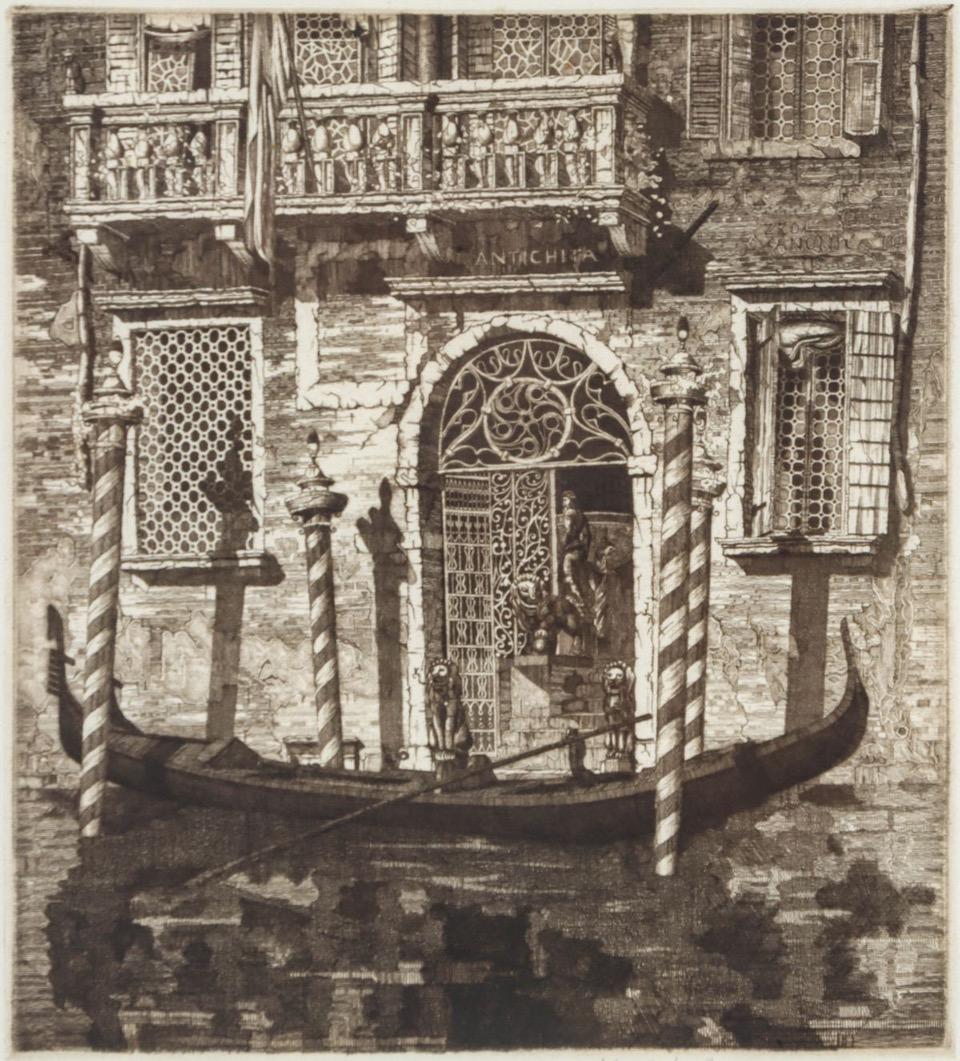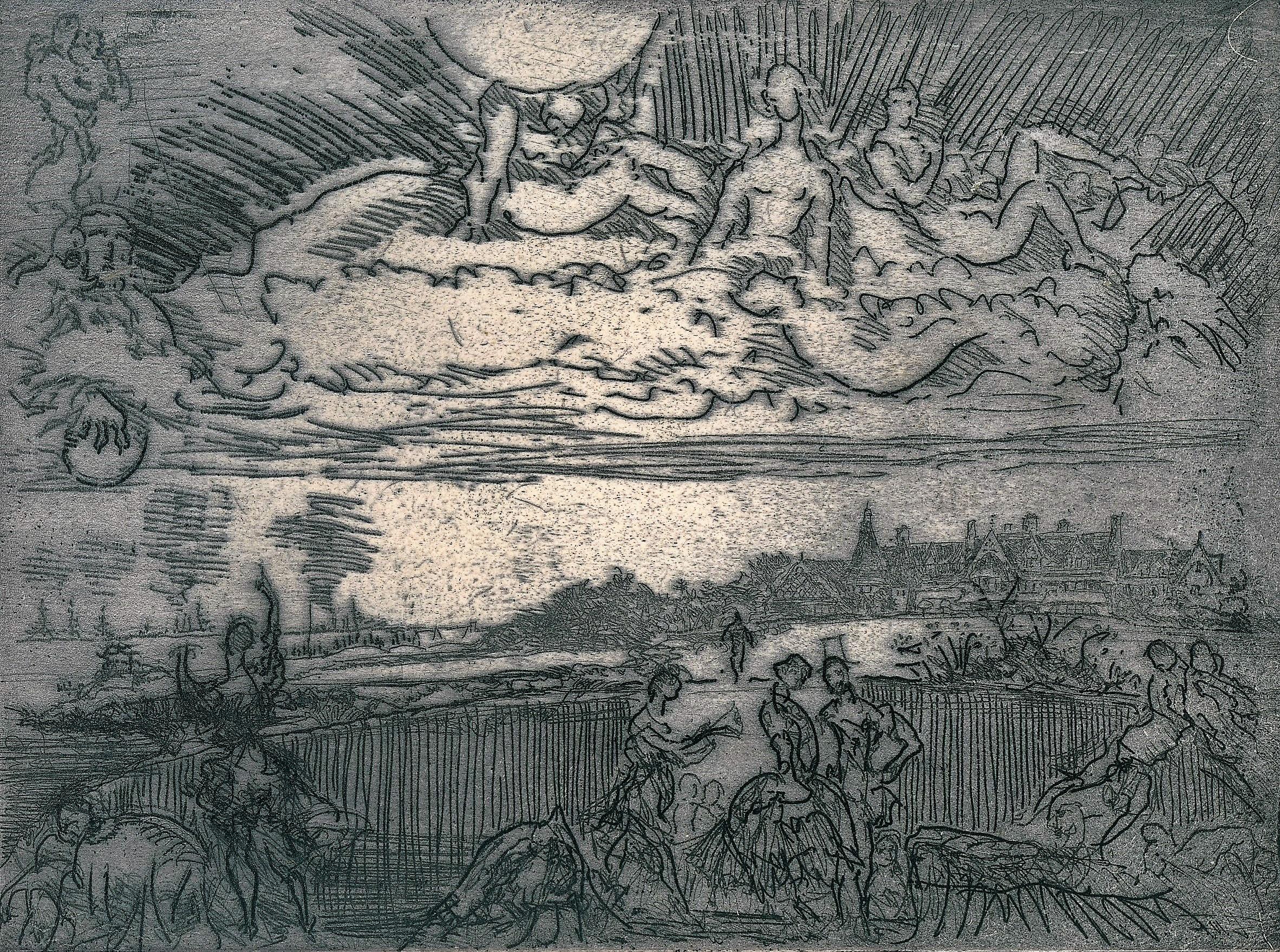Items Similar to "The Caissons Go Rolling Along".
Want more images or videos?
Request additional images or videos from the seller
1 of 7
Kerr Eby"The Caissons Go Rolling Along". 1929
1929
About the Item
"The Caissons Go Rolling Along". 1929. Etching and sandpaper ground. Giardina 145. 17 3/8 x 9 1/2 (sheet 18 3/4 x 11 1/2). Edition 90. Slight mat line, otherwise find condition. A rich impression with plate tone, printed on antique laid paper. Illustrated: Flint, Contemporary American Etching, 1930. Signed and annotated 'Ed 90' and 'imp' (imprimit) in pencil, indicating a proof printed Eby.
Giardina writes, p. 145: "This etching was based on Eby's World War I experiences in France. Its title was taken from the popular wartime song of the same name."
.
In 1917, when the United States entered World War I, Eby joined the U.S. Army. He tried to obtain a commission as an artist, but was assigned first to ambulance duty and later as a sergeant in the 40th Engineers in France. During the war he documented in drawing what he saw and experienced and on his return to New York City, he translated his studies into prints. Drawings of his World War I experiences launched his career. He spent most of WWI on the front line camouflaging the big guns. During his spare time, he would sketch everything from the big guns to the dead soldiers in the field. He sent these drawings home each week. Upon his return from the war, these drawings became his inspiration for his first successful group of etchings. He continued creating a series of war-related prints throughout the 1920s and '30s. Many galleries exhibited his work, but Frederick Keppel, the great print dealer and a relative of Eby, was the exclusive gallery for many of his new prints.
- Creator:Kerr Eby (1890 - 1946, American)
- Creation Year:1929
- Dimensions:Height: 20 in (50.8 cm)Width: 16 in (40.64 cm)Depth: 2 in (5.08 cm)
- Medium:
- Movement & Style:
- Period:
- Condition:
- Gallery Location:Storrs, CT
- Reference Number:1stDibs: LU33521061433
About the Seller
5.0
Recognized Seller
These prestigious sellers are industry leaders and represent the highest echelon for item quality and design.
Platinum Seller
These expertly vetted sellers are 1stDibs' most experienced sellers and are rated highest by our customers.
Established in 1977
1stDibs seller since 2016
698 sales on 1stDibs
Typical response time: 1 hour
Associations
International Fine Print Dealers Association
- ShippingRetrieving quote...Ships From: Storrs, CT
- Return PolicyA return for this item may be initiated within 3 days of delivery.
More From This SellerView All
- Bailey's Beach, Newport, Rhode Island.By Clifford Isaac AddamsLocated in Storrs, CTBailey's Beach (Newport, Rhode Island). c. 1931-1933. Etching and drypoint. Hausberg catalog 126 state vi. Edition 75. 6 x 7 7/8 (sheet 9 9/16 x 12 1/2). Printed on cream wove paper ...Category
Mid-20th Century American Modern Landscape Prints
MaterialsDrypoint, Etching
- Bailey's Beach, Newport, Rhode Island.By Clifford Isaac AddamsLocated in Storrs, CTBailey's Beach (Newport, Rhode Island). 1933. Etching. Hausberg 126 state v/vi. Edition 75. 6 x 7 7/8 (sheet 9 3/8 x 12 3/8). Printed with extensive plate tone with plate tone on 'Va...Category
Mid-20th Century American Modern Landscape Prints
MaterialsDrypoint, Etching
- Caprice, or House on Cliff Walk, Newport, Rhode IslandBy Clifford Isaac AddamsLocated in Storrs, CTHouse on Cliff Walk, Newport, Rhode Island or Caprice, Newport, Rhode Island.. 1931/33. Etching. Hausberg catalog 138 state ii. 5 15/16 x 8 (sheet 7 7/8 x 9 5/8). A rich impression ...Category
Mid-20th Century American Modern Landscape Prints
MaterialsDrypoint, Etching
- Wall StreetBy Joseph PennellLocated in Storrs, CTWall Street. 1904. Etching. Wuerth 344. 11 3/4 x 7 7/16 (sheet 15 1/2 x 10 1/4). Edition about 75. A rich, tonal impression printed on Japanese mulberry paper. Signed in pencil. Hous...Category
Early 20th Century American Modern Landscape Prints
MaterialsDrypoint, Etching
- Spring Night, Greenwich VillageBy Martin LewisLocated in Storrs, CTSpring Night, Greenwich Village. 1930. Drypoint and sand ground. McCarron 85. 10 x 12 3/8 (sheet 13 1/4 x 15 5/8)). Edition 92. A rich, tonal impress...Category
1930s American Modern Figurative Prints
MaterialsDrypoint, Etching
- Building a Babylon, Tudor City, NY.By Martin LewisLocated in Storrs, CTMcCarron 76. 12 7/8 x 7 7/8 (sheet 16 5/8 x 12 1/4). 6th trial proof (McCarron records 84 impressions including 4 trial proofs). Illustrated L'Amérique de la Dépression: Artistes En...Category
Early 20th Century American Modern Landscape Prints
MaterialsEtching, Drypoint
You May Also Like
- Irving Guyer, Christmas Trees on Second Street (NYC)By Irving GuyerLocated in New York, NYPhiladelphia-born Irving Guyer attended the Art Students League and worked in New York City before moving to California. This print is signed and titled i...Category
1930s American Modern Figurative Prints
MaterialsDrypoint, Etching
- Guardians of the Spire; Amiens Cathedral Number 2By John Taylor ArmsLocated in Middletown, NYGuardians of the Spire; Amiens Cathedral Number 2 New York: 1937. Etching and drypoint on watermarked F.J. Head cream-colored, antique laid paper, 6 3/4 ...Category
Mid-20th Century American Modern Figurative Prints
MaterialsDrypoint, Etching
- Palazzo dell'AngeloBy John Taylor ArmsLocated in Middletown, NYPalazzo dell'Angelo 1931 Etching and drypoint on cream-colored, handmade laid paper with deckle edges, 7 1/4 x 6 3/4 inches (185 x 171 mm), edition of 100, full margins. Signed, dated and numbered "Ed. 100" in pencil, lower margin, second state (of three). Printed by Henry Carling, New York. Extremely minor mat tone and some inky residue in the top right corner, all unobtrusive and well outside of image area. An exquisite impression of this intricate image, with astonishing detail, and all the fine lines printing clearly. The image represents the first print which Arms printed on his own handmade paper. Framed handsomely with archival materials and museum grade glass in a wood gilt frame with a flower and garland motif. Illustrated: Dorothy Noyes Arms, Hill Towns and Cities of Northern Italy, p. 180; Anderson, American Etchers Abroad 1880-1930; Eric Denker, Reflections & Undercurrents: Ernest Roth and Printmaking in Venice, 1900-1940, p. 116. [Fletcher 233] Born in 1887 in Washington DC, John Taylor Arms studied at Princeton University, and ultimately earned a degree in architecture at the Massachusetts Institute of Technology in 1912. With the outbreak of W.W.I, Arms served as an officer in the United States Navy, and it was during this time that he turned his focus to printmaking, having published his first etching in 1919. His first subjects were the Brooklyn Bridge, near the Navy Yard, and it was during his wartime travel that Arms created a series of extraordinarily detailed etchings based on Gothic cathedrals and churches he visited in France and Italy. He used what was available to him, namely sewing needles and a magnifying glass, to create the incredibly rich and fine detail that his etchings are known for. Upon his return to New York after the war, Arms enjoyed a successful career as a graphic artist, created a series of etchings of American cities, and published Handbook of Print Making and Print Makers (Macmillan, 1934). He served as President of the Society of American Graphic Artists, and in 1933, was made a full member of the National Academy of Design. In its most modern incarnation, Palazzo dell'Angelo was constructed in or around 1570. The building, which has a rich and storied history, was erected upon the ruins of an earlier structure which predates the Gothic period. Some remnants of the earliest features of the residence were most certainly still visible when Arms visited, as they are today. Having a background in architecture, there's no question that Arms was moved by the beauty, history and ingenuity represented in the physical structure. One thing specifically gives away Arms's passion for the architecture, and that is the fact that he focused on the building's Moorish entranceway, balustrade, and two mullioned windows, and not on the curious Gothic era bas-relief of an angel nestled into the facade of the building, after which the structure is named. The sculpture itself doesn't appear in Arms's composition at all, despite the fact that it is the feature of the building that is most famous in its folklore. Arms instead focuses on the oldest portion of the architecture, even documenting some of the remnants of a fresco, and a funerary stele for the freedman Tito Mestrio Logismo, and his wife Mestria Sperata (visible above the water level, to the left of the door, behind the gondola), which was first described in 1436. Among the many notable bits of history regarding the Palazzo, it has been documented that Tintoretto painted frescos of battle scenes on the facade of the building. The paintings have been lost to time and the elements, but not entirely to history. The empty frame...Category
1930s American Modern Figurative Prints
MaterialsDrypoint, Etching
- Steps to the Grand Canal, St. Mark's in the distance, Venice.By Donald Shaw MacLaughlanLocated in Middletown, NYA lovely view of Venice from the water. Etching with drypoint on antique cream laid paper with a large figural watermark, signed in pencil, lower right. 14 1/4 x 11 inches (362 x 280...Category
Early 20th Century American Modern Landscape Prints
MaterialsLaid Paper, Drypoint, Etching
- Tugs on the HudsonBy Charles Frederick William MielatzLocated in Middletown, NYDrypoint etching with engraving printed in black ink on Japanese mulberry paper, 4 1/2 x 3 3/8 inches (113 x 84 mm), full margins. In superb condition. A beautiful New York City rive...Category
Early 20th Century American Modern Landscape Prints
MaterialsHandmade Paper, Drypoint, Etching
- Comanche Dance, Ildefonso Pueblo, New Mexico Southwest Framed EtchingBy Gene KlossLocated in Denver, COComanche Dance at San Ildefonso Pueblo (New Mexico). Etching and drypoint, artist's proof from an edition of 50 prints. Presented in a custom frame, outer dimensions measure 22 ¼ x 18 ½ x ½ inches. Image size is 11 ¾ x 14 ½ inches. Print is clean and in very good vintage condition - please contact us for a detailed condition report. Expedited and international shipping is available - please contact us for a quote. About the Artist: Gene (Alice Geneva) Kloss is considered one of America’s master printmakers. She was born in Oakland, California and established herself as an artist on the West coast. Kloss was introduced to etching by Perham Nahl while at UC Berkley. She graduated in 1924, and in 1925 married poet Phillips Kloss. In her late twenties, Kloss moved to Taos, New Mexico and began her life’s work of the New Mexican landscape and peoples. It was at this time that she received national acclaim. Her artwork exudes an unmistakable content and style. Enchanted by the architecture, mountainous landscapes and rituals of the inhabitants, Kloss captured the beauty of the Southwest and surrounding areas. Her style was bold yet deftly simple, masterfully expressing the elusive Southwestern light...Category
1980s American Modern Figurative Prints
MaterialsDrypoint, Etching





